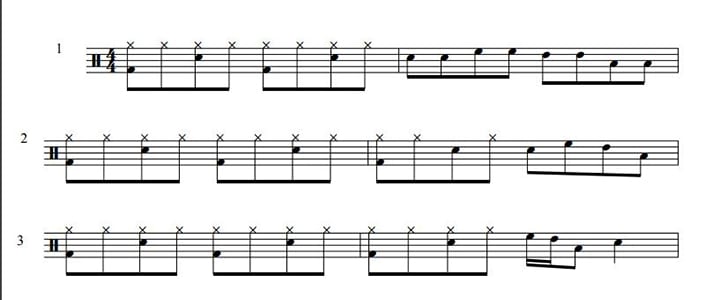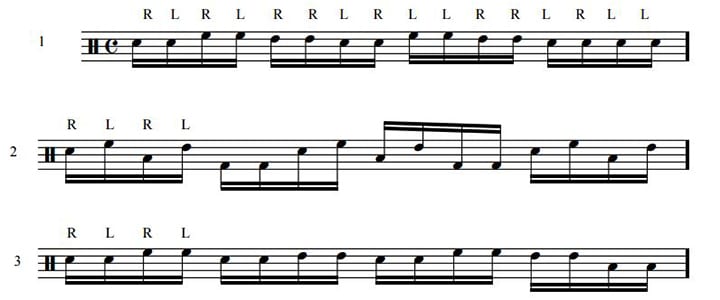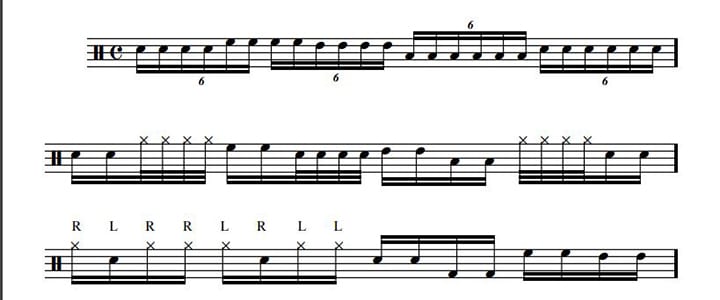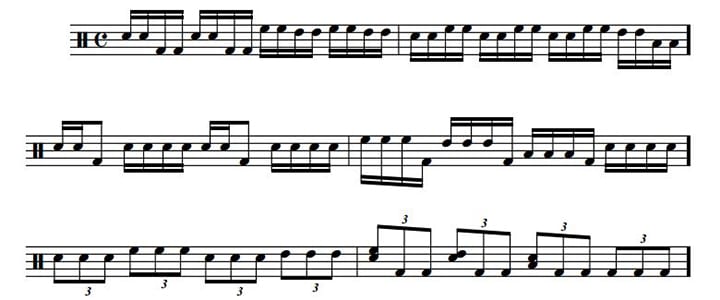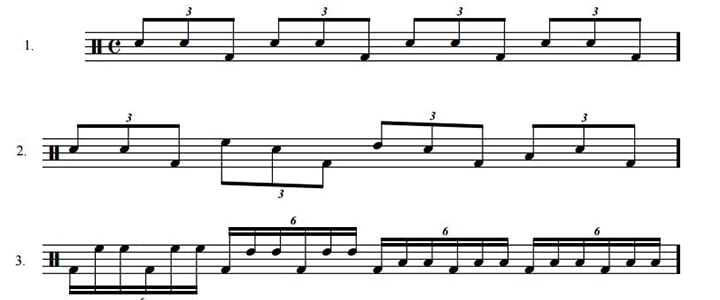It’s time for drum practice with Tracy D! Whether you’re a beginner or an intermediate drummer, grab your sticks and get ready to learn these 15 fun and easy drum fills…
What is a Drum Fill?
In simple terms, a drum fill is a transition when you move from one musical selection to another. Because it signals the shifts of sections in a tune (and they’re a departure from the groove), it’s an essential part of your song. Musicians can also use fills to create a specific mood.
Drum fills can help you spice up your songs and get the listener excited for the next part. They can be as straightforward or as complex as you please, but they should always be in the style of the tune. Sometimes, the simplest fills convey the most feeling. Here, I will explain a bit about drum fills in different categories.
Before getting into the fills, make sure you practice drum rudiments and these drum exercises for independence and control.
For the following patterns, play three measures of time/groove before playing the fills. Make sure you can transition back into the groove. Some of the fills have doubles in the bass, so they’re good to get your foot in gear.
Beginner Drum Fills
If you’re still new to drumming, these easy drum fills will help you get started. Try to keep your strokes evenly spaced. Play your kick on the quarter beat through the fills.
Exercise 1 is a full-bar fill that takes you around the kit with two 8th notes on each drum.
Exercise 2 is a half-bar fill with one 8th note on each drum.
Exercise 3 is tricky because of the sparseness of the fill. Here, you have to be sure that you give beat four its total value. Your tendency (as a beginner) may be to rush through that space.
Once you feel comfortable playing these fills, reverse the order of the notes, make the fills longer or shorter, and experiment with orchestration (voices).
After some practice, you will gain facility and confidence in your playing. Be sure to use your metronome; this will keep you honest.
Looking for more beginner drum fills? Try these 16th-note fills for beginners.
Cool Drum Fills
Here are a few sweet little 16th-note fills that you may enjoy. Once you feel comfortable with these, change up your voices and stickings.
Exercise 1 has you using some mixed stickings and playing some doubles on your toms. This mix gives you plenty of time to get back to the snare. Playing the kick on the quarter beat gives a nice six-over-four phrasing.
Exercise 2 teaches you to sweep laterally, and the doubles on the kick help throw you back to the snare. This fill is fun to play (when you get used to it). Be sure that you hit with precision and that your bass notes are solid and evenly spaced. This is also an example of a linear fill, which we will discuss below.
Exercise 3 is a sweep in a vertical fashion before terminating in a run around the kit. Play the kick on the quarter beat.
These cool drum fills are fun, and they will strengthen your core if you use proper posture. The sweeping motions will provide a different way to get the rebound to work for you as you move from drum to drum. Start out slowly to establish accuracy.
Advanced Drum Fills
Once you have mastered the beginner fills, you may want to give these advanced drum fills samples a try. Depending on your level, it will take some work. Be patient with yourself and stick with it.
These add tuplets, 32nd notes, and mixed stickings. Play the kick on the quarters here, also.
Exercise 1 has the first two beats in phrases of four within a tuplet feel and allows a release by resolving back to six on the last two beats. For an effect that I call “fill cleaner,” accent the last note of each beat as an exercise of its own. Pay particular attention to the feel of your subordinate hand-throwing that beat to your foot, then remove the accent. You should find that your fills sound and feel more balanced.
Exercise 2 has you play the 32nd notes as singles or doubles. The space between the end of beat three and the beginning of beat four is a bigger move for your core as you turn from the floor tom to the hats. Your speed on this move will dictate your tempo for the exercise.
Exercise 3 is a fill that uses paradiddles for beats one and two and allows for either single or double stroke stickings in the last two beats.
Metal Drum Fills
These fills are two bars of fun, and they’re great for building tension.
Exercise 1 is a fun run around the kit (play the kick on the quarters of the 2nd measure). Start out slowly to build accuracy, and then challenge yourself to increase the tempo.
Exercise 2 incorporates more of the bass.
Exercise 3 is a triplet-based fill that ends with a common rock feel.
A metal drum fill doesn’t necessarily have to be note-dense to be effective. Experiment with orchestration on these.
Linear Drum Fills
More cool drum set fills are often called “gallops”, and they’re good examples of linear figures (no two notes played in unison). Aim for smooth, even triplets.
Use these exercises as ideas to experiment with voices and stickings. Try playing some of the notes on the rims, ride-bells, etc.
Play with your metronome! Set up subdivisions (8ths, 16ths, 32nds, tuplets) to ensure accurate note placement. Start at a slow speed, and bump it up as you gain facility.
Key Takeaways and Tips
Once you’ve got these down, try creating your own drum fills samples. Our top tip for mastering these is to get your timing right. This will ensure your rhythm is on point and help you play faster.
You can start by playing slow and increase your speed as you go. Building your way up ensures your drum playing sounds meticulous! The whole purpose of fills is for the listener to understand and enjoy your tunes, so don’t let it sound messy by playing faster than you’re ready for.
Most importantly, have fun and practice often. If you want help mastering fills and other drumming skills like a pro, consider taking private lessons that are customized just for you!
 Post Author: Tracy D.
Post Author: Tracy D.Tracy D. teaches percussion and drum lessons in Edmond, OK, as well as online. She has been playing the drums with various bands for more than 13 years. Tracy earned her Bachelor’s in Music Education from Oklahoma Christian University and has played with the OKC Community Orchestra since 2009. Learn more about Tracy here!
Maile Proctor


